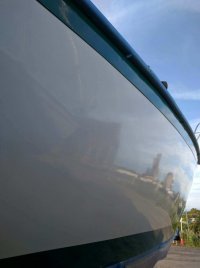Bolo
Contributing Partner
The hull on our E-32 III (1987) is getting a bit dull, especially at the dark blue boot & shear line stripes. I've polished the hull myself in the past and also had the yard do the job too with "OK" results. An outside (of the yard) vendor, who has done some nice work for me in the past, took a look at the boat and suggested wet sanding the gel coat. Anything beyond that would require painting the hull which I think is a "dollar too far". His estimate reads like this: De-stain, Wet sand gel coat surface, Machine compound, Machine polish, Machine wax using the UV Profile product line. His estimate is $1,100 for a 32 foot hull. Has anyone ever had any experience with wet sanding? I understand the concept and logic seems to say that it will give me a good shine but we all know how logical thinking can go sometimes. I'm not expecting a brand new looking hull, just one that has little or no haze especially in the blue stripes with an improved shine that will be easier to polish and wax myself later. I live about 80 miles for the boat and I'm a "seasoned citizen" so although I could do the work myself it would be a bit difficult and I figure I'd give the pros a shot at it first.






